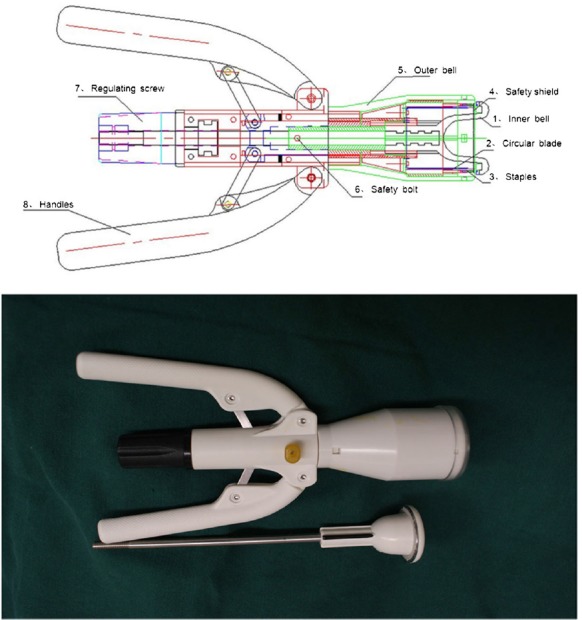Stapler Circumcision
Male circumcision (MC) was one of the earliest operations performed by humans. This procedure has the potential to decrease the risk of sexually transmitted diseases such as human papillomavirus, genital ulcer disease, and human immunodeficiency virus (HIV) infection. Additionally, it improves penile topical hygiene and reduces the incidence of balanitis and penile cancer.
Conventional MC as recommended by the World Health Organization (WHO) includes three techniques: the dorsal slit, the forceps-guided method, and sleeve resection. However, complications such as bleeding, edema, and unsatisfactory cosmetic results are still common in patients who undergo conventional MC. Moreover, conventional MC is time consuming.
The Chinese Shang Ring was recently introduced worldwide. The use of this device is associated with a shorter operative time, lower blood loss volume, and fewer postoperative complications than in conventional MC. However, use of the Shang Ring also has some drawbacks: more time is required for wound healing, patients must endure pain for 7 to 16 days until the ring can be removed, and wound dehiscence is relatively common after the ring is removed because the procedure is sutureless.
The circular stapler, a new disposable circumcision device, has been developed for commercial use in China . It includes two parts: an inner bell and an outer bell. The inner bell is designed to protect the glans. The outer bell comprises a circular blade to cut the foreskin and staples to close the wound for simultaneous hemostasis. We performed a prospective randomized clinical trial involving four urological departments to investigate the safety and efficacy of MC with a circular stapler in adult male patients.

Is Stapler Circumcision Safe
Just like other techniques of circumcision including laser, stapler circumcision is a safer process. However, it has got it’s own benefits when compared to other methods of circumcision that are mentioned below:
- The time taken for the operation / surgery is less than 10 minutes.
- Blood loss is 5 times lesser than other methods of surgery.
- The pain experienced by the patient is way less than the other methods.
- Healing time is quicker but barely by a day or two.
- Possibility for complications is less than half compared to other circumcision techniques.
- Less bleeding
- Near 0 chances of wound (caused by surgery) re-opening
- Less Edema
- Lower chances of infection.
Patient Selection
This clinical trial was approved by the Zhejiang University Ethics Committee, and patients provided written informed consent before undergoing the procedures. All enrolled patients were adult men 18 to 70 years of age with a redundant prepuce or phimosis. The exclusion criteria were acute infection of the genitalia (acute posthitis or balanitis), a thickened prepuce secondary to chronic inflammation, severe foreskin adhesion, or other contraindications to MC such as a concealed penis or sexually transmitted disease.
In total, 879 patients were prospectively enrolled in the present study from March 2013 to March 2014. The patients were from four urological departments (The First Affiliated Hospital, Beilun People’s Hospital, Yuyao People’s Hospital, and Xiangshan First People’s Hospital) and divided into 2 groups: 441 underwent stapler circumcision, and 438 underwent conventional circumcision. All patients were advised to avoid sexual intercourse and masturbation for at least 4 weeks after circumcision.
Surgical technique
n the stapler group, the appropriate size of the stapler device was first determined by measuring the penis just below the glans. The penis was then surgically disinfected with povidone-iodine. A dorsal penile nerve block and a circumferential block were performed with 1% lidocaine, and the treatment was conducted according to a defined protocol.
In the conventional group, all patients underwent MC with the dorsal slit technique using an electric scalpel (Sanli Medical Equipment Company, China) in accordance with the WHO guidance manual. All circumcisions were performed by well-trained urologists.
Benefits/Advantages of Stapler (zsr) Circumcision
- Minimal injury to the tissue and lower blood loss (by volume)
- Shorter operation time
- Fewer post-op complications
- Faster recovery compared to conventional circumcision
- Procedure can be safely performed on children and adults.
The main disadvantage of this stapler circumcision is the need to remove the residual staples after surgery. Most of the times, a surgeon will be required to remove the staples after or during recovery. Research to overcome this disadvantage is being performed by some medical teams who are trying to use a plastic gasket underneath the staples or by improving the material of the staples.
Surgical technique
n the stapler group, the appropriate size of the stapler device was first determined by measuring the penis just below the glans. The penis was then surgically disinfected with povidone-iodine. A dorsal penile nerve block and a circumferential block were performed with 1% lidocaine, and the treatment was conducted according to a defined protocol.
In the conventional group, all patients underwent MC with the dorsal slit technique using an electric scalpel (Sanli Medical Equipment Company, China) in accordance with the WHO guidance manual. All circumcisions were performed by well-trained urologists.
Results
Patient characteristics were well balanced between the two groups. There were no statistically significant differences in age, sexual experience, or infection history. More patients in the conventional group had phimosis. The operative time and blood loss volume were significantly lower in the stapler group than in the conventional group (6.8 ± 3.1 vs 24.2 ± 3.2 min and 1.8 ± 1.8 vs 9.4 ± 1.5 mL, respectively; P<0.01 for both). The intraoperative and postoperative pain scores were significantly lower in the stapler group than in the conventional group (0.8 ± 0.5 vs 2.4 ± 0.8 and 4.0 ± 0.9 vs 5.8 ± 1.0, respectively; P<0.01 for both). Additionally, the stapler group had a significantly lower complication rate than did the conventional group (2.7% vs 7.8%, respectively; P<0.01). However, the treatment costs were much higher in the stapler group than in the conventional group (2215.2 ± 51.2 Yuan (US$356.60±8.20) vs 785.5 ± 43.5 Yuan (US$126.50±7.00), respectively; P<0.01). Similar patient satisfaction was achieved in the two groups.

